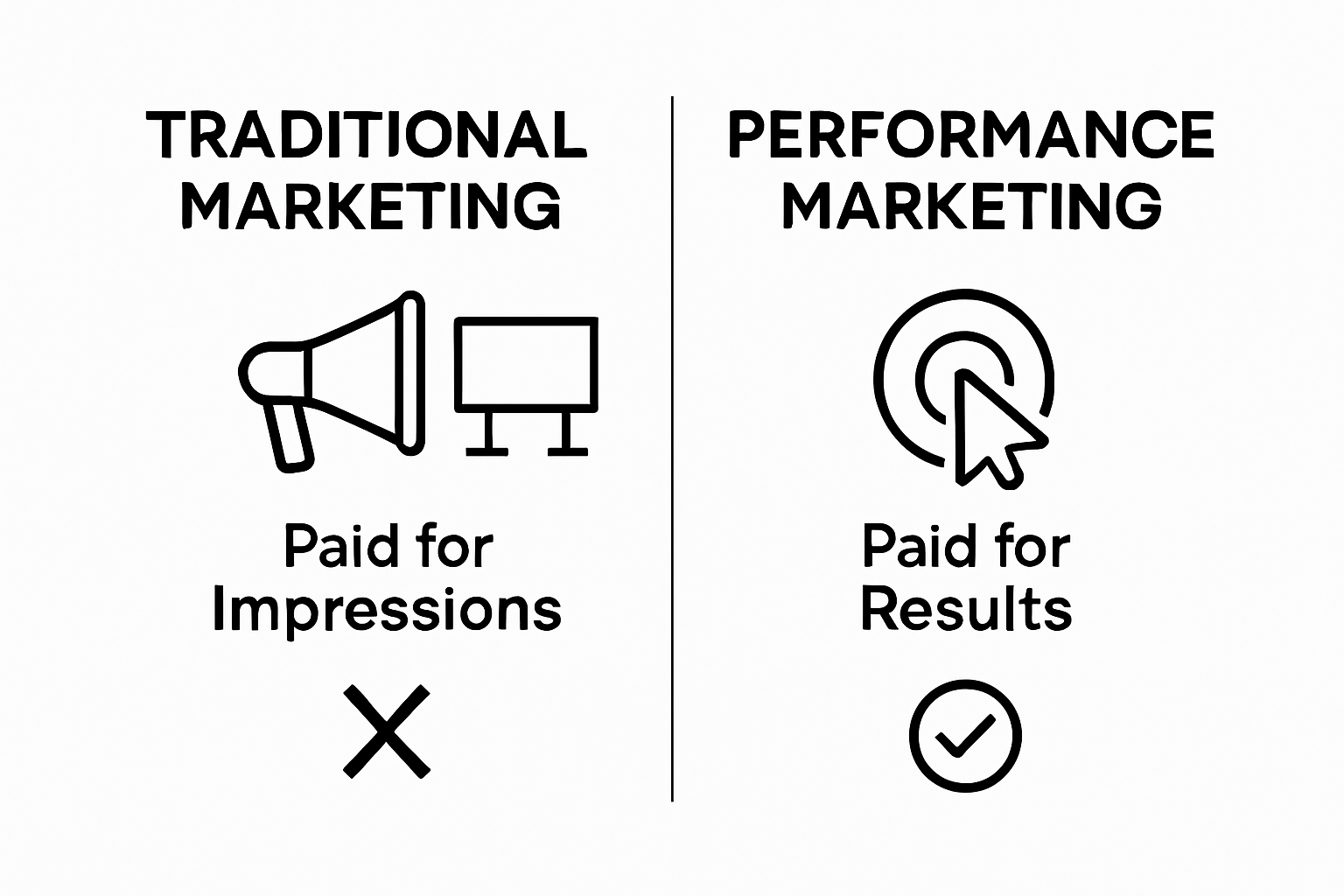What is Performance Marketing? Understanding Its Impact
Performance marketing turns the old rules of advertising upside down. Most brands still pay big bucks for ad space just to be seen, but in performance marketing, you pay only for real results like clicks, leads, or sales. That flips the risk equation for businesses and hands them total control and accountability over every dollar spent.
Table of Contents
- Defining Performance Marketing: Core Concepts Explained
- The Importance of Performance Marketing in Today’s Marketplace
- How Performance Marketing Operates: Key Mechanisms
- Understanding the Metrics That Matter in Performance Marketing
- Real-World Applications and Success Stories of Performance Marketing
Quick Summary
| Takeaway | Explanation |
|---|---|
| Pay Only for Results | Brands spend on performance marketing when specific actions like purchases or leads occur, ensuring value for their investment. |
| Focus on Measurable Metrics | Key performance indicators help businesses assess ROI and campaign effectiveness, optimizing marketing strategies based on data. |
| Real-Time Optimization | Advanced analytics allow businesses to adjust campaigns on-the-fly, improving effectiveness and reducing wasted spend. |
| Reduced Financial Risk | Businesses minimize financial exposure by paying only for verified customer interactions, promoting accountability in advertising. |
| Transform Data into Insights | Instead of static numbers, businesses should analyze metrics to derive actionable insights that enhance marketing strategies. |
Defining Performance Marketing: Core Concepts Explained
Performance marketing represents a revolutionary approach to digital advertising where brands pay exclusively for specific, measurable results rather than traditional impression-based models. Unlike conventional marketing strategies that charge for visibility, performance marketing focuses on quantifiable outcomes like clicks, conversions, sales, or specific user actions.
The Fundamental Mechanics of Performance Marketing
At its core, performance marketing operates on a results-driven framework that transforms how businesses approach digital advertising. Advertisers only pay when a precise, predetermined action occurs. These actions might include:
- A completed purchase
- A generated lead
- A website registration
- A product download
- A successful app installation
This model provides businesses with unprecedented transparency and accountability. Explore our guide on marketing automation to understand how these precision targeting techniques integrate with broader digital strategies.
Measuring Success Through Precise Metrics
According to research exploring digital marketing strategies, performance marketing distinguishes itself through rigorous measurement and tracking. Key performance indicators (KPIs) become the primary evaluation mechanism, allowing brands to:
- Calculate exact return on investment (ROI)
- Track customer acquisition costs
- Understand precise campaign effectiveness
- Optimize marketing spend in real time
By leveraging advanced analytics and tracking technologies, performance marketing enables businesses to make data-driven decisions, ensuring every marketing dollar is strategically invested for maximum impact and efficiency.
The Importance of Performance Marketing in Today’s Marketplace
In an increasingly competitive digital landscape, performance marketing has emerged as a critical strategy for businesses seeking measurable and efficient marketing outcomes. Unlike traditional marketing approaches that rely on broad reach and visibility, performance marketing provides direct accountability and precise return on investment.

Transforming Business Growth Strategies
Performance marketing enables businesses to optimize their marketing spend by focusing exclusively on verifiable results. Discover our essential ecommerce marketing strategies to understand how targeted approaches can drive significant growth. The methodology offers several compelling advantages:
- Immediate trackability of marketing efforts
- Cost-effective advertising models
- Reduced financial risk for businesses
- Precision targeting of specific audience segments
- Real-time performance optimization
Economic Efficiency in Digital Advertising
According to research exploring digital marketing strategies, performance marketing positively influences marketing performance by providing businesses with unprecedented insights into their advertising effectiveness. Brands can now make data-driven decisions that directly impact their bottom line.
By leveraging advanced tracking technologies and analytics, performance marketing transforms digital advertising from a speculative expense into a strategic investment. Companies can now allocate resources with surgical precision, ensuring that every marketing dollar generates measurable value and contributes directly to business growth.
How Performance Marketing Operates: Key Mechanisms
Performance marketing functions through a sophisticated ecosystem of digital platforms, tracking technologies, and strategic methodologies that enable precise measurement and optimization of marketing efforts. The fundamental objective is transforming marketing from a cost center into a revenue generation mechanism.
Tracking and Attribution Technologies
At the heart of performance marketing are advanced tracking technologies that capture every customer interaction with remarkable granularity.
Learn more about marketing automation techniques to understand how these systems integrate seamlessly. These technologies enable businesses to:
- Monitor user journeys across multiple digital touchpoints
- Assign precise value to each marketing interaction
- Track conversions with pixel-level accuracy
- Identify most effective marketing channels
- Understand complex customer behavior patterns
Compensation and Reward Models
Performance marketing distinguishes itself through unique compensation structures that align advertiser and publisher incentives. According to research exploring digital marketing strategies, these models typically include:
- Cost Per Click (CPC)
- Cost Per Action (CPA)
- Cost Per Lead (CPL)
- Cost Per Sale (CPS)
- Revenue Share Arrangements
These models ensure that marketing investments are directly tied to measurable outcomes, creating a transparent and accountable ecosystem where financial risk is dramatically reduced.
The following table summarizes the main compensation and reward models in performance marketing, along with their key characteristics and what each model measures.
| Model | What is Measured | Key Characteristic |
|---|---|---|
| Cost Per Click (CPC) | Clicks on an advertisement | Advertisers pay only when a user clicks the ad |
| Cost Per Action (CPA) | Specific user actions | Payment is tied to completion of a predefined action |
| Cost Per Lead (CPL) | Form submissions/leads | Advertisers pay when a user becomes a lead |
| Cost Per Sale (CPS) | Completed sales/conversions | Payment only for actual purchases |
| Revenue Share | Percentage of sales revenue | Advertisers share a portion of resulting sales revenue |
| Advertisers pay only for verified, successful interactions, transforming marketing from a speculative expense to a predictable investment strategy. |
Understanding the Metrics That Matter in Performance Marketing
Performance marketing thrives on precision, with carefully selected metrics serving as the compass that guides strategic decision making. These metrics transform raw data into actionable insights, enabling businesses to understand exactly how their marketing efforts translate into tangible results.
Key Performance Indicators in Digital Marketing
Learn about measuring content marketing ROI to gain deeper insights into performance tracking. The most critical metrics for performance marketing encompass a comprehensive range of measurements:
- Conversion Rate
- Customer Acquisition Cost (CAC)
- Return on Ad Spend (ROAS)
- Lifetime Value (LTV)
- Click Through Rate (CTR)
- Cost Per Acquisition (CPA)
Interpreting Metrics for Strategic Decision Making
According to research on marketing performance metrics, successful performance marketing goes beyond simple number tracking. Metrics must be contextualized and analyzed holistically. Businesses need to understand not just the numbers, but the story behind them.
Each metric provides a unique perspective on marketing effectiveness.
This table outlines key performance indicators (KPIs) used in performance marketing, defining each metric and describing the specific strategic insight it provides to businesses.
| Metric | Definition | Strategic Insight Provided |
|---|---|---|
| Conversion Rate | Percentage of visitors who complete a desired goal | Measures effectiveness of campaigns |
| Customer Acquisition Cost (CAC) | The cost to acquire a new customer | Assesses financial efficiency of marketing efforts |
| Return on Ad Spend (ROAS) | Revenue earned for every dollar spent on advertising | Shows profitability of ad campaigns |
| Lifetime Value (LTV) | Total revenue expected from a customer | Guides long-term value and retention strategies |
| Click Through Rate (CTR) | Percentage of users who click on an ad | Evaluates ad appeal and relevance |
| Cost Per Acquisition (CPA) | Average cost to acquire a customer through a campaign | Determines cost-effectiveness of ad investments |
| Conversion rates reveal how compelling your messaging is, while customer acquisition cost demonstrates the financial efficiency of your campaigns. Return on ad spend connects marketing investments directly to revenue generation, providing a clear picture of campaign profitability. |
The ultimate goal is transforming these metrics from static numbers into dynamic insights that continuously refine and improve marketing strategies, ensuring every marketing dollar is strategically invested for maximum impact.

Real-World Applications and Success Stories of Performance Marketing
Performance marketing has transformed how businesses approach digital advertising, providing tangible proof that data-driven strategies can deliver remarkable results across diverse industries. These real-world success stories demonstrate the power of precision targeting and measurable outcomes.
E-commerce and Direct-to-Consumer Triumphs
Discover proven strategies to increase online sales and understand how performance marketing drives revenue. Success stories in this sector reveal compelling strategies:
- A fitness apparel brand reduced customer acquisition costs by 40% through targeted social media campaigns
- An online cosmetics company increased conversion rates by implementing sophisticated retargeting techniques
- A subscription meal service achieved 200% ROI by leveraging performance marketing channels
Cross-Industry Performance Marketing Innovations
According to research exploring digital marketing strategies, performance marketing transcends traditional industry boundaries. Successful implementations demonstrate versatility across sectors:
- Technology startups using performance marketing to rapidly scale user acquisition
- Healthcare providers optimizing patient engagement through precise digital campaigns
- Financial services firms reducing marketing spend while improving lead quality
These examples illustrate how performance marketing is not just a strategy but a comprehensive approach to understanding and optimizing customer interactions. By focusing on measurable outcomes and continuous improvement, businesses can transform their marketing from a cost center to a revenue generation engine.
Ready to Turn Performance Marketing Insights Into Real Revenue?
You have seen how performance marketing promises measurable results and true accountability. Yet, many brands struggle to turn clicks into loyal customers or to keep their hard-won leads engaged over time. The article highlights pain points like inefficient ad spend and the need for transparent, ROI-driven campaigns. These are exactly the problems Take Action solves for ecommerce brands and online businesses.

If you want to maximize every dollar of your marketing budget, let us show you how advanced email automation, precise segmentation, and tailored campaign strategies can take your growth to the next level. We use Klaviyo and AI-driven insights to convert one-time buyers into repeat customers, recover abandoned carts, and create automated flows that drive real, measurable success. Discover how your performance marketing can achieve lasting results with a partner who specializes in automating and optimizing your customer retention process. Visit our main site to see how your brand can experience scalable growth and data-driven retention today.
Frequently Asked Questions
What is performance marketing?
Performance marketing is a digital advertising strategy where brands pay only for specific, measurable results such as clicks, conversions, or sales, rather than for ad visibility.
How does performance marketing measure success?
Success in performance marketing is measured using key performance indicators (KPIs) like conversion rates, customer acquisition cost (CAC), and return on ad spend (ROAS), which allow businesses to track effectiveness and optimize marketing efforts.
What are the core benefits of performance marketing?
The core benefits of performance marketing include immediate trackability of marketing efforts, cost-effective advertising, reduced financial risk, precision targeting of audience segments, and real-time campaign optimization.
What compensation models are commonly used in performance marketing?
Common compensation models in performance marketing include Cost Per Click (CPC), Cost Per Action (CPA), Cost Per Lead (CPL), Cost Per Sale (CPS), and revenue share arrangements, ensuring advertisers pay only for successful interactions.
Recommended
- Understanding Marketing Automation Explained Simply | Take Action Blog | Take Action
- Understanding Marketing Automation Basics for Brands | Take Action Blog | Take Action
- Understanding Measuring Content Marketing ROI for Brands | Take Action Blog | Take Action
- Scaling Digital Marketing: Strategies for 2025 Success | Take Action Blog | Take Action
- What is Digital Marketing? Understanding Its Importance
